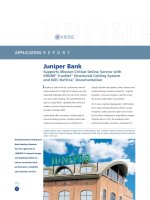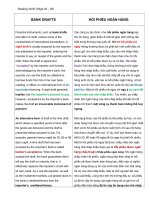Central Bank pptx
Bạn đang xem bản rút gọn của tài liệu. Xem và tải ngay bản đầy đủ của tài liệu tại đây (688.4 KB, 18 trang )
Chapter 16
What Should
Central Banks Do?
Monetary Policy
Goals, Strategy,
and Tactics
Copyright © 2007 Pearson Addison-Wesley.
All rights reserved. 16-2
The Price Stability Goal
•
Low and stable inflation
•
Inflation
Creates uncertainty and difficulty in planning
for future
Lowers economic growth
Strains social fabric
•
Nominal anchor
•
Time-inconsistency problem
Copyright © 2007 Pearson Addison-Wesley.
All rights reserved. 16-3
Other Goals of Monetary Policy
•
High employment
•
Economic growth
•
Stability of financial markets
•
Interest-rate stability
•
Foreign exchange market stability
Copyright © 2007 Pearson Addison-Wesley.
All rights reserved. 16-4
Should Price Stability be the
Primary Goal?
•
In the long run there is no conflict
between the goals
•
In the short run it can conflict with
the goals of high employment and
interest-rate stability
•
Hierarchical mandate
•
Dual mandate
Copyright © 2007 Pearson Addison-Wesley.
All rights reserved. 16-5
Monetary Targeting
•
Flexible, transparent, accountable
•
Advantages
Almost immediate signals help fix inflation
expectations and produce less inflation
Almost immediate accountability
•
Disadvantages
Must be a strong and reliable relationship
between the goal variable and the targeted
monetary aggregate
Copyright © 2007 Pearson Addison-Wesley.
All rights reserved. 16-6
Inflation Targeting I
•
Public announcement of medium-term
numerical target for inflation
•
Institutional commitment to price stability as
the primary, long-run goal of monetary policy
and a commitment to achieve the inflation goal
•
Information-inclusive approach in which many
variables are used in making decisions
•
Increased transparency of the strategy
•
Increased accountability of the central bank
Copyright © 2007 Pearson Addison-Wesley.
All rights reserved. 16-7
Inflation Targeting II
•
Advantages
Does not rely on one variable to achieve target
Easily understood
Reduces potential of falling in
time-inconsistency trap
Stresses transparency and accountability
•
Disadvantages
Delayed signaling
Too much rigidity
Potential for increased output fluctuations
Low economic growth during disinflation
Copyright © 2007 Pearson Addison-Wesley.
All rights reserved. 16-8
Copyright © 2007 Pearson Addison-Wesley.
All rights reserved. 16-9
Copyright © 2007 Pearson Addison-Wesley.
All rights reserved. 16-10
Copyright © 2007 Pearson Addison-Wesley.
All rights reserved. 16-11
Implicit Nominal Anchor
•
Forward looking and preemptive
•
Advantages
Uses many sources of information
Avoids time-inconsistency problem
Demonstrated success
•
Disadvantages
Lack of transparency and accountability
Strong dependence on the preferences, skills, and
trustworthiness of individuals in charge
Inconsistent with democratic principles
Copyright © 2007 Pearson Addison-Wesley.
All rights reserved. 16-12
Copyright © 2007 Pearson Addison-Wesley.
All rights reserved. 16-13
Tactics:
Choosing the Policy Instrument
•
Tools
Open market operation
Reserve requirements
Discount rate
•
Policy instrument (operating instrument)
Reserve aggregates
Interest rates
May be linked to an intermediate target
•
Interest-rate and aggregate targets
are incompatible
Copyright © 2007 Pearson Addison-Wesley.
All rights reserved. 16-14
Copyright © 2007 Pearson Addison-Wesley.
All rights reserved. 16-15
Copyright © 2007 Pearson Addison-Wesley.
All rights reserved. 16-16
Criteria for
Choosing the Policy Instrument
•
Observability and Measurability
•
Controllability
•
Predictable effect on Goals
Copyright © 2007 Pearson Addison-Wesley.
All rights reserved. 16-17
The Taylor Rule, NAIRU,
and the Phillips Curve
Federal funds rate target =
inflation rate + εθυιλιβριυµ ρεαλ φεδ φυνδσ ρατε
+1/2 (ινφλατιον γαπ)+1/2 (ουτπυτ γαπ)
•
An inflation gap and an output gap
Stabilizing real output is an important concern
Output gap is an indicator of future inflation as shown by
Phillips curve
•
NAIRU
Rate of unemployment at which there is no tendency for
inflation to change
Copyright © 2007 Pearson Addison-Wesley.
All rights reserved. 16-18









